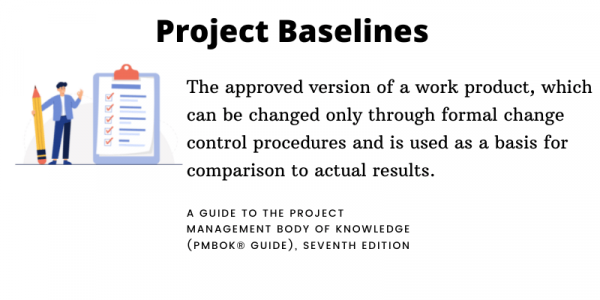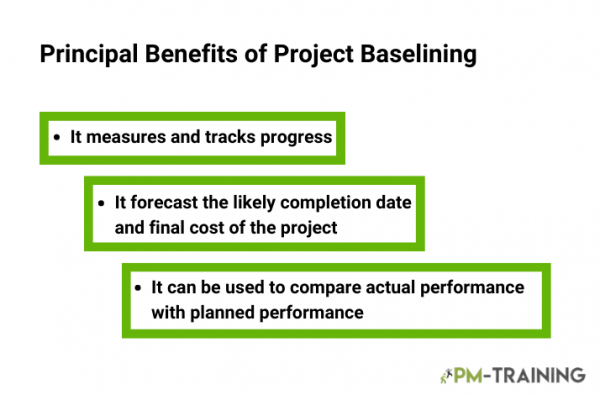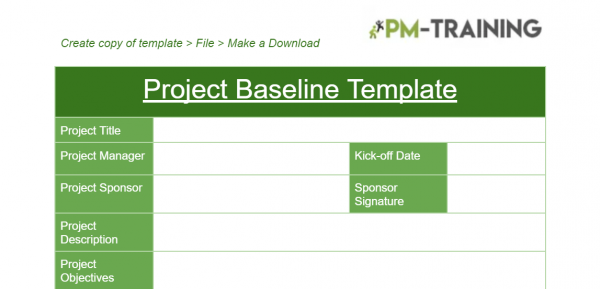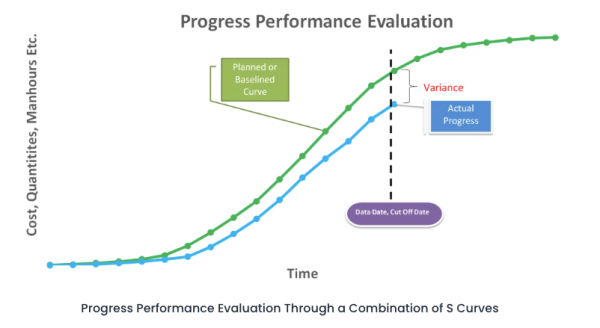In project management, a baseline is the original approved version of a project plan. It is used to track and measure progress against the project’s objectives. The baseline is typically created at the beginning of a project, and it can be updated as the project progresses.

This whole project baseline is a set of approved documents that establish the starting point for a project. These documents can include the project Charter, the Project Scope Statement, the project management plan, and the project timeline.
As it is an approved version of the project, it should be changed only through formal change control procedures. The project management plan strictly enforces these baselines and dictates change processes in order to prevent scope creep.
Components of a project baseline
There are three types of baselines in project management: schedule baseline, cost baseline, and scope baseline.
Schedule Baseline
A schedule baseline is a snapshot of the project schedule at a given point in time. It is used as a baseline against which actual progress can be measured. It is usually set at the beginning of the project after the project schedule has been developed.
This baseline includes the project timeline and deliverables, as well as the planned start and end dates for each task.
Cost Baseline
The cost baseline is important for tracking the costs of a project and for ensuring that the project stays within its budget. It is also a useful tool for assessing the feasibility of a project and for determining whether or not a project is worth pursuing.
It also includes the period of time over which the project will be completed, the tasks to be performed, and the time-phased schedule of costs.
Scope Baseline
It encompasses the quality expectations, deliverables, and requirements that have been agreed upon by the project team. It also includes the project management plan and results of any previous work that has been done. This information is used to create a baseline against which all future work will be compared.

Importance of a project baseline
The project baseline is established at the start of the project and includes a set of predetermined performance goals that the project team strives to meet.
Without a baseline, it is difficult to track progress, identify issues, and course correct when necessary, so it is a key component of success in project management.
In summary, project baselining is critical because of its benefits:

How to Create and Use Project Baseline
A Performance Measurement Baseline is a document that specifies how a project will be measured. It includes objectives, success criteria, and a work breakdown structure. As the project progresses, a Performance Measurement Baseline (PMB) is used to track the project’s progress and compare it against the set goals. This allows the project manager to identify any areas of concern and take corrective action as needed.
Define Scope baseline
Define the project’s objectives and deliverables. Make sure all stakeholders agree on the scope of the project.
Define Schedule baseline
Create a project schedule that includes milestones and deadlines. Make sure all stakeholders agree on the schedule.
Define Cost Baseline
Develop a budget plan that outlines your expected costs. Make sure all stakeholders agree on the budget.
Establish key performance measures and indicators of the baselines
Schedule – You’ll need to identify the project milestones. These are the key deliverables that need to be completed in order for the project to be considered a success. Once you’ve identified the milestones, you can add them to the schedule baseline.
Cost – There are many different ways to create a cost baseline. One popular method is to use the work breakdown structure (WBS). This is a document that breaks down a project into smaller tasks and subtasks. Another method is to use the activity-based costing (ABC) method. Often used in conjunction with the WBS. Costs are then assigned to each activity.
Measurements and Changes
Variance Analysis– Variance analysis is a technique that can be used to identify deviations from the baseline. This information can be used to make necessary adjustments to the project plan.
Integrated Change Control – Integrated change control is a project management process that helps ensure that changes to the project are properly documented, coordinated, and approved. The goal of this process is to prevent changes from causing disruptions to the project or adversely affecting project quality. There are three main types of change control: preventive, corrective, and defect repair.
1. Preventive change control is used to prevent potential problems from occurring.
2. Corrective change control is used to address problems that have already occurred.
3. Defect repair is used to fix defects that have been found in the project.
Communicating PMB
When communicating make sure goals of integrated change control are safe, changes are made in a controlled and coordinated manner, and all stakeholders are kept informed of the changes. By keeping all stakeholders informed and by having a process in place to approve or reject changes, the project can stay on track and within budget.
Project Baseline Template
Project Baseline Google Doc
We have created the below project baseline template on Google Docs which compliments our other templates. You can create your own copy here.

Project Baseline Excel Template
Project Baseline Template Excel template is an excellent template with a WBS dictionary and WBS tree diagram for you to use.
Track Project Baseline with S curve
The S curve is a valuable tool for project managers, as it can help them to track the progress of a project and to identify potential problems.
This tool is crucial as it empowers you to make better-informed decisions about properly allocating resources. As it is used to track the path of a project from its inception to its completion, it is often used to predict how much work remains to be done.
This technique allows you to track any project, from the building of a bridge to the development of a new software application.

Project Baseline Example
Imagine you’re the project manager in charge of a team assigned to develop an eCommerce website for XYZ Co. You’ve been assigned a specific amount of money and it is estimated that it is going to take a whole year to develop it. During the planning phase, make sure when creating the project baseline, this includes:
Project requirements and goals
A list of what the project aims to accomplish and what the project team hopes to achieve. For example Scope: Ecommerce website
Detailed budget
A breakdown of all the costs associated with the project. For example Cost: $300,000
Project Baseline Schedule
A detailed schedule of all the milestones and tasks that need to be completed. For example Schedule: 12 months
The baseline should be set at the beginning of the project and updated as needed throughout the course of the project only through integrated change control. By regularly reviewing the baseline, you can ensure that the project is on track and make necessary adjustments if things start to go off course.
Avoid Project Baseline Variance
Not having a clear understanding of your baselines in a project can bring a lot of problems.
Scope creep
This is when the project’s scope begins to creep beyond the originally agreed-upon parameters. This can happen for a number of reasons, such as a change in client requirements or a misunderstanding of the project’s objectives.
Budget overruns
A lack of a baseline can also lead to budget overruns, as it can be difficult to track progress and costs without a clear starting point. This can be a major problem for businesses, as uncontrolled costs can quickly eat into profits.
Schedule delays
If the project’s objectives and milestones are not clearly defined, it can lead to delays in the project schedule. This can be frustrating for everyone involved in the project, as it can extend the timeline and cause hard-to-repair consequences.
Gold Plating
Gold plating is the process of adding extra features or functionality to a product or service that is not strictly necessary. In project management, gold plating can refer to the practice of adding unnecessary features or functionality to a project in order to make it look more impressive or valuable.
While it’s understandable to want to make a project the best it can be, gold plating can be a costly mistake.
It can lead to scope creep, cost overruns, and schedule delays. It’s important to avoid gold plating in project management, as it can jeopardize the success of the project and cause problems for the team.
Project Baseline FAQs
What is a Project Baseline?
A project baseline is a fixed set of criteria against which progress and results can be measured. This can include the project’s schedule, budget, and scope
How many types of project baselines are there?
There are three baselines. One is the cost baselines, the second scope baseline, and the schedule baseline. All together can also be described as a Performance Measurement Baseline.
What is the S Curve?
It is a tool for Project Managers that identifies potential problems and tracks the project’s overall progress.
Why is project baseline important?
A project baseline is important because it allows you to track the project’s progress and identify any deviations from the original plan. The baseline can be used to measure progress, identify issues and areas of concern, and track changes and trends over time.
